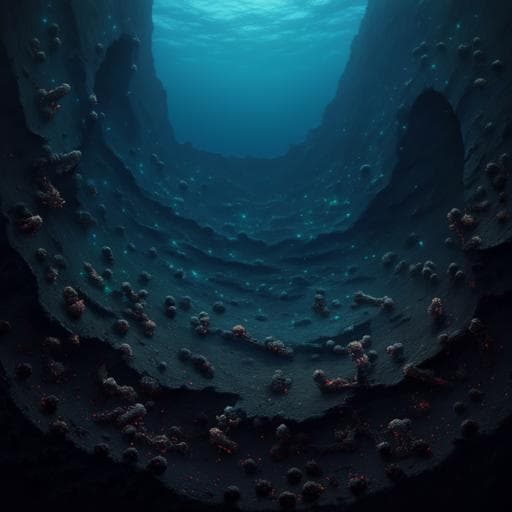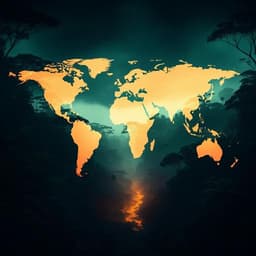
Earth Sciences
The hadal zone is an important and heterogeneous sink of black carbon in the ocean
X. Zhang, Y. Xu, et al.
Discover the groundbreaking research by Xi Zhang and colleagues on black carbon accumulation in the hadal zone—the ocean's deepest trenches. Their study reveals that black carbon, sourced from terrestrial plants and fossil fuels, makes up 10% of total organic carbon in these depths, highlighting the hadal zone as an unexpected major sink for black carbon. Dive into this riveting exploration of our planet's less-known ecosystems!
~3 min • Beginner • English
Introduction
Black carbon (BC) is a refractory, combustion-derived carbonaceous material with long environmental lifetimes, facilitating its transport to remote oceans. Prior estimates suggested an ocean sediment BC burial flux of ~10.3 Tg yr−1, with only ~0.6 Tg yr−1 in deep-sea sediments, despite deep-sea BC/TOC ratios often exceeding those on shelves. The hadal zone (6000–11,000 m water depth), comprising ~1% of seafloor area but 45% of ocean depth range, is underexplored due to sampling challenges. Hadal trenches have elevated organic carbon (OC) accumulation, biomass, and microbial activity, attributed to topographic funneling, seismic events, and energetic near-bottom flows. Given the association between BC and TOC in sediments, the study hypothesizes that substantial BC accumulates in the hadal zone. The research aims to quantify BC content and isotopic signatures (δ13C, Δ14C) in sediments from six trenches to determine sources, spatial variability, and to assess the hadal zone’s role in global BC burial.
Literature Review
Previous work reported BC in sublittoral, bathyal, and abyssal zones but lacked data for the hadal zone. Deep-sea BC has been viewed as refractory and old (~20 ka BP), whereas recent observations of dissolved BC in the Mariana Trench suggested cycling on timescales comparable to bulk DOC, challenging the refractory paradigm. Hadal trenches have documented enhanced OC accumulation and diagenesis, and can receive large sediment and OC inputs during seismic events (e.g., Japan Trench). Global emissions of BC from fossil fuel combustion (~6.6–7.2 Tg yr−1) and biomass burning (~196–340 Tg yr−1) provide potential sources. Stable carbon isotopes (δ13C) can distinguish terrestrial C3, C4, and marine sources, and radiocarbon (Δ14C) differentiates fossil versus modern biomass-derived BC. However, different analytical methods capture different fractions of the BC continuum, and dissolved versus particulate BC may have distinct biogeochemical behaviors. These gaps motivate direct measurements of sedimentary BC in hadal settings to resolve sources, ages, and burial.
Methodology
Sampling: Short sediment cores (to 40 cm) were collected from hadal and adjacent non-hadal sites across six Pacific trenches during three cruises (2016–2018): Mariana (MT), Mussau (MST), New Britain (NBT), Bougainville (BT), Kermadec (KT), and Atacama (AT). Sites span different productivity regimes (48–449 g C m−2 yr−1), depths (1560–10,840 m), and terrestrial influences.
Sample pretreatment: Freeze-dried, homogenized sediments were decarbonated with 1 M HCl (24 h), rinsed to neutrality, dried, and homogenized. For samples with extremely low BC, an additional HF concentration step (24 h) was applied without subsequent rinsing to avoid OC/BC loss; tests showed HF treatment did not significantly alter BC content (BC with HCl+HF = 1.112 × BC with HCl − 0.026; r = 0.93, p < 0.01).
BC quantification: The CTO-375 method operationally defined BC as residual carbon after heating acid-treated sediment at 375 °C for 24 h in air.
Elemental and stable isotope analyses: Contents and δ13C of TOC and BC were measured using a Vario Pyro Cube elemental analyzer coupled to an Isoprime 100 IRMS. Acetanilide served as an in-lab standard. Precision: ±0.03% (content), ±0.2‰ (δ13C). Surface sediments (top 1–5 cm; n=22) and two cores (A9 abyssal, A10 hadal; 29 samples) were analyzed.
Radiocarbon (Δ14C): For samples >50 µg C, combustion with CuO at 900 °C (8 h), CO2 purification and graphitization followed by AMS at CIGC-QNLM. For low-C samples (~28 µg), EA combustion with direct CO2 injection to MICADAS via GIS at OUC-CAMS. Standards: NIST SRM4990C (Oxalic II), blanks: phthalic anhydride; procedural blanks 1.50 ± 0.38 µg C, Fm 0.47 ± 0.12. Radiocarbon reported as fraction modern and conventional ages; values corrected for blanks.
Sedimentation rates: Adopted constant linear sedimentation rates based on excess 210Pb profiles from prior studies and local cores, excluding mass-wasting layers: NBT 0.08–0.16 cm yr−1, BT 0.13–0.20, AT 0.026–0.085, KT 0.030–0.042, MT 0.038 cm yr−1.
Source apportionment: A two-endmember Δ14C mixing model estimated contributions from biomass burning (Δ14C ≈ +50‰, approximating modern atmospheric CO2) and fossil carbon (Δ14C ≈ −1000‰; fossil fuel and rock weathering grouped). Equations: Δ14Csed = Δ14Cbiomass fbiomass + Δ14Cfossil ffossil; fbiomass + ffossil = 1. Pre-aged terrestrial BC with intermediate Δ14C not explicitly modeled.
BC burial calculation: BC accumulation rates (AR; g m−2 yr−1) computed from BC content (wt.%), dry bulk density, and sedimentation rate for five trenches (MT, NBT, BT, KT, AT). Global hadal BC burial extrapolated by multiplying mean AR by total hadal area (~3.4 × 10^6 km^2). TOC burial similarly estimated.
Key Findings
- Surface sediment TOC: 0.15–2.39 wt.% across trenches; trench means: MT 0.31%, MST 0.57%, NBT 0.45 ± 0.18%, BT 0.26 ± 0.08%, KT 0.24 ± 0.09%, AT 0.87 ± 0.58%. TOC δ13C: −24.4‰ to −19.9‰; trench means ~−20 to −23‰. TOC Δ14C: −891‰ to −82‰ (ages ~17,790 to 690 yr BP); trench means: MT −391‰, MST −418‰, NBT −172 ± 65‰, BT −224 ± 126‰, KT −683 ± 157‰, AT −446 ± 151‰.
- Surface sediment BC: 0.011–0.18 wt.%; trench means: MT 0.013%, MST 0.071%, NBT 0.024 ± 0.009%, BT 0.014 ± 0.002%, KT 0.036 ± 0.007%, AT 0.077 ± 0.046%. BC δ13C: −27.7‰ to −22.3‰; trench averages: MT −24.3‰, MST −24.0‰, NBT −23.7 ± 0.9‰, KT −25.9 ± 0.9‰, AT −25.7 ± 1.0‰ (no BC δ13C for BT). BC Δ14C: −893‰ to −346‰ (ages ~17,870 to 3340 yr BP); trench averages: MT −626‰, MST −661‰, NBT −473 ± 77‰, BT −415 ± 49‰, KT −729 ± 105‰, AT −694 ± 164‰.
- BC constitutes ~10% of trench TOC on average; inter-trench BC content highest in AT; BC/TOC ratio highest in KT (0.17 ± 0.05), followed by AT (0.11 ± 0.08), NBT (0.074 ± 0.049), BT (0.058 ± 0.017).
- Correlations: BC vs TOC content r = 0.43 (p < 0.05); BC/TOC vs TOC Δ14C r = −0.59 (p < 0.01), indicating BC content influences bulk TOC radiocarbon ages. HF effect test: BC(HCl+HF) = 1.112 × BC(HCl) − 0.026; r = 0.93 (p < 0.01).
- Along-trench heterogeneity: Significant site-to-site variability in BC and BC/TOC along AT and KT axes; in AT, BC generally decreases from landward abyssal to hadal axis to oceanward sites, indicating dominant landward sources; patterns differ in NBT/BT, implying multiple source regions.
- Isotopic offsets: BC δ13C (−25.1 ± 1.2‰) is more negative than TOC δ13C (−21.9 ± 1.4‰), indicating predominantly terrestrial BC vs more marine TOC. In 20 of 22 sites, BC Δ14C is more negative than TOC Δ14C, with mean age offset ~3720 years, consistent with older, refractory BC.
- Source apportionment (Δ14C mixing): Fossil carbon contribution ffossil ranges 38–90% (mean 64 ± 16%); biomass fbiomass 10–62% (mean 36 ± 16%). Highest biomass fractions in NBT (50%) and BT (56%); intermediate in MST (32%) and MT (36%); lowest in KT (26%) and AT (29%), consistent with proximity to industrialized regions (KT) and sparse vegetation but fossil sources (AT).
- Dissolved vs sedimentary BC: Sedimentary BC δ13C more negative than dissolved BC reported for hadal waters and open ocean, suggesting different sources and/or fractionation; authors propose mineral protection limits isotopic fractionation for particulate BC.
- Depth profiles (AT cores): A9 (abyssal) TOC 0.90–1.56%, BC 0.11–0.20%; δ13C TOC −21.7 to −21.1‰, BC −26.6 to −25.9‰; Δ14C (TOC) −319, −434, −760‰ (surface to deeper); Δ14C (BC) −457, −453, −767‰. A10 (hadal) TOC 1.01–2.07%, BC 0.09–0.18%; δ13C TOC −22.2 to −21.2‰, BC −26.4 to −25.6‰; Δ14C (TOC) −311 to −403‰ with depth; Δ14C (BC) −430 to −502‰. BC contents in surface layers similar to core means, supporting use of surface sediments for AR estimates.
- BC accumulation rates (AR): 0.07–0.48 g m−2 yr−1; mean 0.29 ± 0.15 g m−2 yr−1 across five trenches; orders of magnitude higher than open-ocean abyssal sediments, comparable to some continental shelves.
- Global implications: Extrapolated hadal BC burial 1.0 ± 0.5 Tg yr−1; updates global marine BC burial from ~10.2 to 11.2 Tg yr−1, with hadal zone contributing 8.7 ± 4.5%. Per unit area, hadal BC burial is ~7× the global ocean average. Estimated hadal TOC burial 17.7 ± 14.1 Tg yr−1, consistent with independent estimates of TOC subduction to trenches.
Discussion
The study confirms that hadal trenches are significant sinks for black carbon, addressing the key question of whether BC accumulates in the deepest ocean. The more negative δ13C and Δ14C signatures of sedimentary BC relative to co-deposited TOC indicate dominant terrestrial C3 and fossil fuel sources, rather than marine production. Spatial heterogeneity in BC content and source contributions reflects environmental controls including proximity to land, regional productivity, vegetation cover, atmospheric transport, and socioeconomic development (industrialization level). For example, KT exhibits high BC/TOC and older BC ages consistent with substantial fossil fuel inputs from nearby industrialized nations, while AT shows high BC content due to high productivity (greater sedimentation), sparse terrestrial OC input, and anthropogenic fossil sources (e.g., mining/urban emissions). The negative relationship between BC/TOC and TOC Δ14C indicates that BC content significantly biases bulk TOC radiocarbon ages toward older values in deep sediments. Differences between dissolved and sedimentary BC isotopic compositions imply distinct sources and/or processing pathways; the authors hypothesize mineral protection of particulate BC limits isotopic fractionation along the land–ocean continuum, unlike dissolved BC which may undergo photochemical and microbial alteration. High BC accumulation rates in hadal settings are attributed to trench geomorphology (V-shaped, steep slopes) that funnels and retains particles, with episodic mass-wasting and seismicity further enhancing delivery. Collectively, these findings elevate the hadal zone’s role in the global BC cycle, necessitating its inclusion in carbon budgets and climate-relevant assessments of refractory carbon sequestration.
Conclusion
This work provides the first comprehensive assessment of black carbon in hadal trench sediments, demonstrating that: (1) BC is widespread and heterogeneous across trenches, averaging ~10% of TOC; (2) isotopic evidence implicates predominant terrestrial C3 and fossil fuel sources; (3) hadal sediments exhibit high BC accumulation rates, making the hadal zone an important, previously underrecognized sink; and (4) the global marine BC burial budget increases to ~11.2 Tg yr−1 with hadal contributions of ~1.0 ± 0.5 Tg yr−1 (8.7 ± 4.5%). Per area, hadal burial is ~7-fold the ocean average. Future research should expand spatial and temporal sampling across more trenches, better constrain sedimentation and mass-wasting impacts, refine source apportionment to include pre-aged terrestrial BC endmembers, test the mineral protection hypothesis for particulate BC, and reconcile differences between dissolved and particulate BC dynamics.
Limitations
- Geographic and sample limitations: Only six trench regions sampled; source apportionment and burial extrapolations are based on five trenches (MST excluded for lack of sedimentation rates). Within-trench heterogeneity and limited station numbers (e.g., single samples for MT, MST) constrain inter-trench comparisons.
- Episodic events: Estimates exclude pulsed inputs from earthquakes and mass-wasting, likely rendering burial fluxes conservative.
- Mixing model simplifications: Two-endmember Δ14C approach groups rock weathering with fossil fuel and omits pre-aged terrestrial BC with intermediate Δ14C, potentially underestimating biomass contributions.
- Methodological windows: BC operationally defined by CTO-375 captures soot/graphitic fractions; results are not directly comparable to methods targeting different BC fractions. Some BC δ13C data are missing (e.g., BT) due to low concentrations.
- Sedimentation rates: Assumed constant linear 210Pb-based rates after excluding event layers; uncertainties in rates and dry bulk densities propagate to AR estimates.
- HF treatment: Although tests indicate minimal impact on BC quantification, concentration steps may introduce minor uncertainties for very low-BC samples.
Related Publications
Explore these studies to deepen your understanding of the subject.







